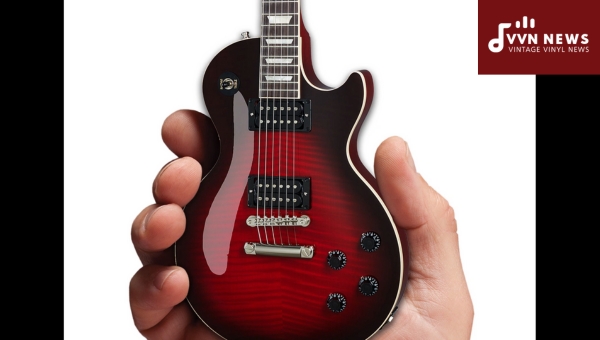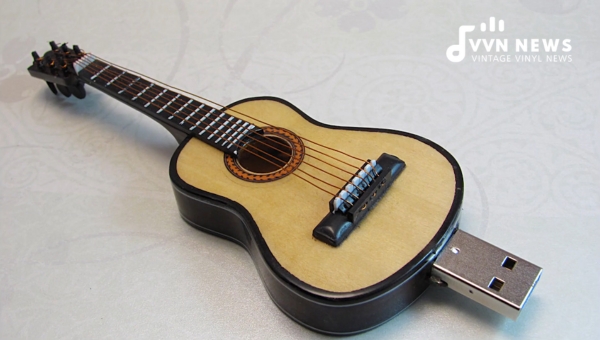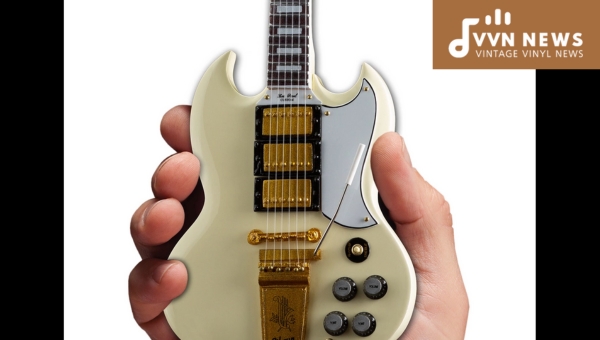Have you ever imagined strumming a much smaller guitar than your pinky nail? Well, wonder no more.
Enter the awe-inspiring nano guitar: the smallest guitar known, a marvel of human innovation that effortlessly blends art and science.
This pint-sized instrument is not just a quirk of whimsical fancy; it’s an actual, playable electric guitar—albeit at a microscopic level.
The creation of the nano guitar is yet another testament to humans’ endless drive to push boundaries and explore new frontiers, even if those new frontiers are remarkably tiny.
It is an intriguing, albeit small (pun intended) step into what could be a whole new era of nanodevices and technology.
What is Nanoguitar?
A nano guitar is a microscopic structure that resembles a guitar, but it is roughly the size of a human cell. It was the first microscopic guitar ever “played.” Developed by Cornell University researchers in 1997.
It’s made of crystalline silicon and measures approximately 50 micrometers long, or about the width of a human hair.
Its purpose focused more on demonstrating a new technology for making tiny machines rather than creating music.
Amazingly enough, the nano guitar stands at only about 10 micrometers long – that’s approximately 100 times tinier than the diameter of a single hair strand!
This miniaturized masterpiece was fabricated from crystalline silicon and boasted all the features you’d expect in a regular guitar: strings, frets, and body.
Its functionality sets this apart from your conventional instrument (besides its size).
Instead of allowing us to make music with our fingers and ears as traditional guitars do, the nano guitar works with lasers and transducers in unimaginable ways with regular instruments.
Origin of Nanoguitar

The creation of the nano guitar dates back to 1997 and is credited to the ingenious minds at Cornell University.
The miniature musical instrument was released as part of an exhibition focusing on around-the-world music.
Interestingly, the nano guitar wasn’t initially intended to be a guitar. It started as a test structure to examine how fabricated components behaved under certain conditions.
The guitar started as a HARP (High Aspect Ratio Process) test structure used to calibrate Cornell’s nano-printing equipment.
The idea of turning this test structure into a guitar-like object came from graduate student Dustin W. Carr, who joined forces with his professor Harold G. Craighead for this initiative.
Before creating the nano guitar, the duo had already been experimenting with microscopic silicon oscillators – devices that vibrate at high frequencies and can store large amounts of energy relative to their size.
Taking their fascination a step further led to the creation of what we today know and marvel at – the nano guitar.
This breakthrough paved the way for future inquiries into micromechanical systems and further highlighted nanotechnology’s incredible capacities, implications, and potential applications within various industries.
Also Read: How To Upgrade Your Flute? [A Comprehensive Buying Guide]
How is a Nanoguitar made?
While intricate, the process of creating a nano guitar can be broken down into several manageable steps.
I aim to help you understand the remarkable precision and expertise in this masterful blend of art, science, and engineering.
Materials & Tools
The nano guitar is shaped out of a single crystal of silicon. The wafer is coated with a layer of resist – a substance sensitive to light or electrons. Most importantly, the entire construction takes place in an ultra-high vacuum chamber.
Patterning the Wafer
For carving out the desired shape (guitar in this case), developers use Electron Beam Lithography. This technology focuses an electron beam on surface areas as tiny as 10 nm.
- The first step involves loading the silicon wafer in the electron beam lithography machine.
- After the wafer is loaded into the system, it’s time to expose it to an electron beam.
- The beam is employed to’ draw’ on the resist coating according to pre-determined patterns.
Developing & Etching
Once done with patterning, development comes next. Using a specific developer solution, highlighted areas are soaked and removed.
- The etching process follows afterward, assisted by numerous chemicals.
- The substances used for etching transfer patterns from resist into silicon substrate underneath.
Release Layer & String suspension
Finally comes the suspension of guitar strings, which heavily involves a release layer construction significant for structure and performance.
- A support layer is created under each string beforehand when resist layers are deposited on top of it, if per se, to suspend guitar strings.
- They are then set free by selectively erasing the support layer underneath them.
With these technically complex yet ingeniously logical steps finalized, the creation of our magical marvel – The Nanoguitar – stands completed!
Cornell’s Role in Nanoguitar Development

In the late 1990s, an exciting collaboration took place in the bustling halls of Cornell University.
A group of dedicated researchers led by Professor Harold G. Craighead rose to prominence as they carved out their mini marvel, marking a significant milestone in nanoelectromechanical systems.
The conceptualization, design, and actualization of the world’s most miniature guitar was an ingenious effort to demonstrate how future nanodevices could be constructed using lithography techniques – a commonly used process in semiconductor manufacturing.
This groundbreaking initiative was undertaken under The National Science Foundation (NSF) funding.
It’s important to understand that this nano guitar wasn’t built for mere novelty value. Instead, it signified a leap towards nanoscale resonant mechanical structures capable of vibrating at radio frequencies.
Furthermore, this initiative remains critical in studying frequency response and other mechanical properties at the nano level.
All this would not have been possible without Cornell’s pioneering steps toward pushing conventional boundaries!
Functioning of a Nanoguitar
When we consider how a typical guitar works, it’s simple: we pluck the strings, and they vibrate, producing sound waves that our ears can detect.
However, functioning with the nano guitar is a different ball game due to its size. Here are five points that will facilitate your understanding:
Vibrational Modes and Frequencies
The nano guitar operates based on vibrational modes and frequencies rather than utilizing sound waves like traditional guitars.
Role of Lasers
To “strum” the nano guitar’s strings, we don’t use our fingers but utilize short pulses from a laser beam. This pulsating laser triggers the strings of the instrument into motion.
Utilization of Resonance Frequencies
Each string produces different resonance frequencies when hit by laser pulses, acting as musical notes in this context.
Translation Into Audible Sound
Remember I said it’s playable? That doesn’t mean the nano guitar makes music we can hear with our naked ears due to its minute size, creating ultra-high pitch sounds beyond the human frequency range.
However, using transducers and state-of-the-art technology, scientists have found ways to convert these frequencies into sounds audible to the human ear!
Limitations Regarding Playing the Nanoguitar
An important detail to note is that playing the nano guitar isn’t possible at room temperature because thermal energy interferes with the resonant vibrations of its strings.
Consequently, it must be placed in excellent conditions for optimum operation.
For instance, at Cornell University (where this marvel was first created), researchers employ vacuum chambers and cryogenic conditions (below -200 °C) while operating or “playing” this tiniest guitar in existence.
Just as every musical symphony spins an enchanting tale, each minuscule component in this world, from electronic chips to mechanical gears, has its tale – a unique frequency often referred to as ‘Resonant Frequency.’
Also Read: 32 Best Guitar Synth Pedals [Upgrade Your Guitar Effects]
Impact on the Music Industry & Future Scope

While the nano guitar may not be hitting your local music store anytime soon, its creation has significant implications for the future of both the technological and music industries.
The nano guitar represents a leap forward in our understanding of miniaturized systems and their properties, potentially paving the way for significant advancements in nanotechnology.
These advancements could lead to computing, health care, environmental science, and potentially even music breakthroughs.
With continued research and development, we may see future musical instruments that leverage nano-technology for enhanced sound design or radically improved portability.
The nano guitar also opens up intriguing opportunities to redefine what we consider a musical experience.
Imagine a world where microscopic ensembles can perform on miniature stages or create immersive sonic landscapes of today.
While this is mainly speculative at present, it’s clear that the potential applications of these tiny technological marvels are as vast as they are fascinating.
Also Read: 20 Best Classical Guitars [Top Picks For A Beautiful Sound]
FAQs About Nanoguitar
How small is the nano guitar?
The nanoguitar is about 10 micrometers long, approximately 100 times smaller than a human hair strand.
Who invented the nano guitar?
The first nano guitar was invented by researchers from Cornell University’s Department of Physics in 1997.
Can you play the nano guitar like a regular instrument?
Not exactly. Instead of using fingers to strike the strings, you need special equipment like lasers and electronic frequency generators.
What is the primary material used in making a nano guitar?
The miniaturized guitar is typically crafted out of crystalline silicon.
Does the invention of the nano guitar have any practical applications?
While not directly applicable to playing music, developing and studying such microscopic mechanical systems open doors to vast possibilities in computing, robotics, environmental monitoring, and more.
Conclusion
The nano guitar, while too small to strum or hear in the conventional sense, symbolizes an immense feat of human innovative prowess.
It’s a miniature testament to our ability to blend science with art and reminds us that boundaries are there for the pushing.
Big isn’t always better – sometimes, the most minor innovations hold the most significant promise of revolutionizing our world.
This tiny marvel paves the way for future silicon devices, MEMS technology, and nanotech sensor applications.








